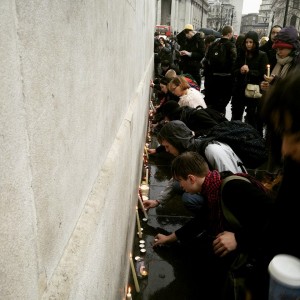Trans Prisoners and where to place them?
With the furore over trans prisoners such as Tara Hudson, a trans woman, being sent to a male prison and her eventual transfer to a female one, another – Vicky Thompson, who took her own life because she was sent to an overcrowded high-suicide risk men’s prison, and another Joanne Latham, two weeks later, it is time to re-address questions of sex/gender policing and segregation in prison. Hudson was sent to prison for violence against a man but presented and identified as female, Latham for two attempted murders and had clear psychiatric issues, as many, especially in women’s prisons do. I did diversity work in HMPs for 5-6 years and was regularly asked what to do with trans prisoners and whether what they were already doing was okay. One HMP had two trans women on the women’s wing, one pre-op one post-op. So they can be flexible. And the 20-30 in UK HMPs is a massive underestimate. I know of dozens and statistically there are probably hundreds.
Prison, Sex and Gender
Prison is an area of mandatory sex/gender segregation based upon the presumption of two sexes and a majority heterosexual population. Separation based upon sex is presumed to aid management, deny sexual privilege, improve safety and risk of sexual and physical violence. All on the basis that men are more likely to harm, harass, or worse, women more than other men. If that is based on size and strength, or merely sex, we should be housing people according to height, weight, and sexuality as well! Where is the protection for gay, lesbian and bisexual, inmates? Trans prisoners, as some intersex prisoners would also, present a binary dilemma.
Inmate violence in US prisons is actually more common between women than between men, up to three times higher for sexual victimisation. What are the facts and myths of gender-based violence and does prison distort them? For instance men are more likely to attempt suicide outside of prison but inside it is women that are more at risk where a higher proportion have mental health issues and concerns.
Where is a safe place to send trans prisoners? In the US they are 50% likely to be raped in prison. Italy has a dedicated trans jail. HMP estimates around 20-30 trans people are in UK prisons but that is likely an underestimate as I’m aware of 10-15 in my local counties.
It is, however, the argument of Germaine Greer and others that women’s spaces need to be kept safe from “men masquerading as women”. The verbal vitriol is almost violent of her anti-trans rhetoric and is something that has led several universities to no-platform her in the name of creating safe trans-inclusive female spaces for students.
What risks are acceptable in the name of free expression (that may contain verbal violence), gender identity, legal sex definition, and how should we balance them with creating safe spaces in universities, DASV/rape crisis support centres, society at large and during incarceration – for all people?
Trans Detention Experience in the USA
“According to a study by University of California Irvine professor Valerie Jenness, more than half of all transgender inmates experience rape. Prison culture also creates an atmosphere where transgender inmates may submit to sexual assault for protection from physical violence – all under the callous indifference of prison authorities.” – The Guardian
“Transgender prisoners are unfathomably at risk for sexual abuse,” Chris Daley, Deputy Executive Director at Just Detention International, an advocacy group that works to end sexual abuse in detention, told VICE News. “It’s a crisis”
“A recent US study said transgender women in male prisons are 13 times more likely to be sexually assaulted than in the general population, with 59 per cent reporting sexual assaults.” – The Independent
“When we are talking about trans people, we are talking about a population who are among the most vulnerable in our prisons,” Rebecca Earlbeck, lawyer representing Sandy Brown.
“Among former state prisoners (US), the rate of inmate-on inmate sexual victimization was at least three times higher for females (13.7%) than males (4.2%)… Following their release from prison, 72% of victims of inmate-on-inmate sexual victimization indicated they felt shame or humiliation, and 56% said they felt guilt.”
Many transgender inmates are placed in “involuntary administrative segregation, which keeps them separated and safe from other inmates.”
“I was forced with no options to be in protective custody, locked down for 23 hours a day,” said Christopher D’Angelo, a transgender male who spent six months in MCSO [Arizona] custody. He likened his detention to solitary confinement. “It just added to my isolation,” D’Angelo said.
Earlier this year, the US Immigration and Customs Enforcement (ICE) was looking to relocate around 25 of the nearly 70 transgender women (there are also a half-dozen or so trans men) that it houses on a nightly basis somewhere more permanent and together, incorporating the 2015 revised trans policies that it has been trying to improve since 2009 and 2011. Barely two-thirds of US facilities are even following the 2011 guidelines.
“The transgender detainees will likely be housed in their own area of the women’s facility, but may be allowed to “mingle” with other female detainees, according to ICE officials.”
Whilst the declared trans women detainees may make up just 0.22% of the 34,000 held, they account for 20% of the sexual abuse cases in detention, and that’s the confirmed reported ones – many are not.
“[US] Immigration officials say they have a model facility in Southern California that only houses gay and bisexual men and transgender women. While some 75 transgender detainees are housed across the country every night, the California facility only houses an average of 44 gay, bisexual and transgender individuals at a time.”
ICE has now cancelled those plans leaving trans immigrants and asylum seekers at risk until improved policies are adopted, although LGBT and immigrant-rights advocates had actually opposed the move because the facility in question had a notorious reputation, disputed by GEO Group and its apparent 100% standards accreditation. Instead, the updated ‘Transgender Care Contract Modification’ policy would allow trans women detainees to be housed in facilities matching their gender identity – a policy the UK adopted in 2011/12, though judging by recent cases, not wholly adopted.
Trans Detention Facilities in Israel
A 24-year-old trans woman in Israel is being reasonably housed at the Neveh Tirtzah women’s prison but kept in isolation at night “due to safety concerns.” She was born into an ultra-Orthodox household as male and began transition as a teen but is serving a third prison term for prostitution, theft and assault. She has complained and filed a petition due to her isolation to which the Israeli Prison Service responded:
“In any case in which a prisoner whose identity is not unambiguous, detention is required in isolation and that is out of concern regarding harm to them or prisoners in the vicinity.”
Trans Detention Facilities in Italy
It is thought that Italy has a total of some 60 transgender prisoners but a specialist centre in Tuscany was planned to house about 30 people. The BBC’s Duncan Kennedy, in Rome, said that until now [2010] transgender prisoners have been located in women’s prisons where they are often segregated for their own safety. Guards were to undertake special training in how to treat transgender prisoners before the prison block was to open near Empoli, in Tuscany, in March 2010.
“It’s a great idea. It will not be a ghetto but a way to avoid the experience of isolation in ordinary prisons,” said Regina Satariano, the head of the Italian Movement for Transgender Identity.
Sadly the Pozzale facility, near Florence, was put on hold. An academic case study – ‘Section D: a Tertium Genus of Incarceration? Case-study on the Transgender Inmates of Sollicciano Prison‘, was recently published (Dec 2014) presenting “a socio-legal analysis of the condition of transgender inmates and of the policy choices (or the lack of them) concerning their incarceration in Italy, based on our case-study of Section D of the Italian Prison of Sollicciano, Florence.”
“…different scenarios share the same conceptual roots: normative binarism and the resulting impossibility of engaging in a political discussion concerning the condition of transgender inmates. Therefore, the second consideration lying at the heart of our study and defining its theoretical and practical framework consists in the necessity of interpreting the complex relations between law and gender, and prison and gender… The condition of transgender inmates globally is evidence of the failure of essentialist policies, grounded on normative binary categories, and the reduction of the social world to the male/female opposition. Employing theory, i.e. critically rethinking the categories of our social space, seems the most logical solution, but logic is not the strong suite of the law (nor of politics). As a result, while legislators envision solely male and female prisoners (and the corollary male and female issues), many correctional institutions are confronted with troublesome ‘specters’ who fail to conform to the legislator’s rational, biopolitical plan…
…Sollicciano is one of the few Italian prisons in which a
tertium genus of incarceration, not provided for by law, has been informally established. The second consideration is the high percentage of non-EU inmates housed in Section D, and the predominance, within this group, of Latin-American inmates, with a significant majority of Brazilians. The last consideration, which lies at the heart of our study and defines its theoretical and practical framework, is the necessity of interpreting the complex relationship between law and gender, and prison and gender. This ‘critical triangle’ defines the object of our study: the theoretical and practical interrelation of law, gender, and rights.”
Trans Detention Experience in the UK
Government estimates of numbers are vastly under-reported. 20-30 is just the tip of the iceberg when there are around 10 in one county alone, to my knowledge, and often 2 or more in each prison, and there are 136 prisons, 82,000 male inmates and 4,000 female inmates. Based upon typical trans statistics that would indicate a few hundred trans inmates, at least. Self-inflicted deaths in custody this year number 43, at least 2 of which were trans, 5% of the total from a population of perhaps 0.5% of inmates (less than 1 in 2000 according to the Government, 0.05%), so at least 10-100x more likely to take one’s life when imprisoned in facilities not matching their gender identity.
Trans and prison reform activists petitioned the Government for over a decade before the PSI 07/2011 Care and Management of Transsexual Prisoners guidance (March 2011) was brought in. I met with prison officers in the few years leading up to that and found that some were taking common sense into their own hands already and in one instance allowing trans women, both pre and post-op, to be moved to the female estate. That, it is not being followed fully 4 years on is a scandal that has led to several high profile deaths in custody.
In ‘Rethinking gendered prison policies: Impacts on transgender prisoners‘,
Sarah Lamble co-founder of Bent Bars Project and a lecturer at Birkbeck School of Law, says:
“Law enforcement officials have a long history of targeting, punishing and criminalising people who do not conform to gender norms. As feminist criminologists have shown, for example, women who fail to conform to femininity norms are often policed and punished more harshly in the criminal justice system than those who adhere more closely to societal gender expectations (Carlen, 1983, 1985; Heidensohn, 1996). Likewise, traditional norms around masculinity and femininity still operate as key modes of discipline, power and regulation within carceral settings (Sim, 1994; Carrabine and Longhurst, 1998; Crewe, 2006). Although the role of gender norms within the penal system is widely recognised, little attention has been paid to their specific impact on transgender people.”
Joanne Latham
A transgender prisoner was discovered dead in her cell at an all-male prison, the BBC reports. Joanne Latham, 38, serving life for three attempted murders, was found hanging by a prison officer at HMP Woodhill (category A) in Milton Keynes in the early hours of Friday 27 November. That she was a patient at the secure Rampton Hospital in 2011 and in the prison’s Close Supervision Centre (CSC) evidences her mental health issues. She had apparently only publicly identified as female this year.
Vicky Thompson

Transgender woman Vicky Thompson was found dead on Friday 13 November at “England’s most overcrowded prison” all-male HMP Leeds (category B), where the infamous violent prisoner Charles Bronson was briefly held. It currently holds 550 more people than the 669 person prison was designed for, with the contingent additional health and safety risks that brings. Thompson identified as female and requested female prison incarceration for her 12 month sentence. She said if she was sent to a male prison she would likely commit suicide. her solicitor described the 21 year old as vulnerable. So sending her to Britain’s second most suicidal jail was not clever thinking. HMP Leeds is second, to HMP Brixton, with “77 self inflicted deaths in custody since 1978. There has been at least one death every year since 1986. From 2010 the number of prison officers has fallen from 383 to 260.”
Tara Hudson
Transgender woman Tara Hudson was moved from a men’s to women’s prison after protests. She was imprisoned for assaulting a bar manager. She had been living full-time for 6 years as a woman since the age of 20. She was released this week.
Jackie Brooklyn, Tara’s mother said on her release:
“Hopefully she will heal in time, but it will have a lasting effect. There needs to be a change in the law and the way prisons deal with transgender inmates in general. We had a letter from Tara’s doctor confirming that she has lived her whole adult life as a woman, but it was completely ignored. Relying on what a passport says is a silly way to decide where people belong.”
A petition that called for Tara Hudson to serve her sentence in a women’s prison attracted 159,000 signatures. At the same time another petition by Cardiff University SU Women’s Officer, Rachael Melhuish, wanted to no-platform Germaine Greer from speaking due to her transmisogynistic views.
Greer’s view has been labelled as radical by those feminists who embrace intersectionality, but Hudson’s treatment at the hands of the Prison Service shows the opposite. If anything, Greer’s disdain is indicative of how we view transgender people as a society. By denying Hudson the right to serve her time in a female prison, our legal system is entirely aligned with statements from Greer such as “Just because you lop off your penis… it doesn’t make you a woman.” – Ella Griffiths in The Independent
Paris Lees
How The Prison Service Is Failing Trans People by Paris Lees
Prison Reform for all
Prison reform is what is needed as society moves forward to accepting people outside the binary. HMP/MoJ would have the same problems with non-binary people, some intersex people, as well as trans people at varying points in transition. Italy tried to solve the problem with a specialist trans prison unit. America is considering the same. Rather than 23hrs solitary which is cruel and inhuman, care and planning needs to go into how to house people who do not confirm for their safety. Prisoners still have human rights even if some civil rights are suspended. Trans people also need to be able to have the conversation with some feminists that also argue a pre-op trans may present a risk to a female prison population, or even if no risk, still present an issue. Indeed, the trans person may still be at risk there.



































